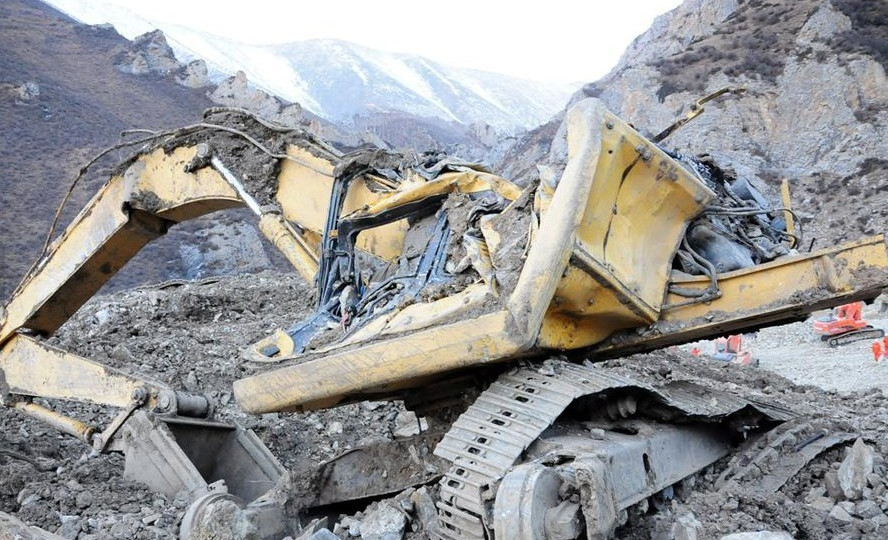High Peaks Pure Earth has translated a blogpost by Woeser written in April 2013 for the Tibetan service of Radio Free Asia and published on her blog on April 30, 2013.
The post is a follow up to the last article on mining in the Gyama area of central Tibet, “Was Lhasa’s Mining Disaster Caused By A ‘Natural Disaster’?”.
To read the full 2011 article “Tibet’s Mining Menace” mentioned in this post and published on “China Dialogue”, please follow this link: http://www.chinadialogue.net/article/show/single/en/4509-Tibet-s-mining-menace-

“Lhasa’s Mining Disaster Clearly Shows the Contamination of the Water Supply Will Continue”
By Woeser
Connecting the “mining disaster” and “Lhasa” together leads us to a matter of far-reaching and severe consequences. Of course, the most important matter is human life. This includes the 83 workers who were buried alive, of which two were Tibetans and the rest Chinese; this also includes the residents living along the lower reaches of Lhasa stream whose lives are being threatened by severe water contamination through mining activities.
In history, Lhasa has never experienced a mining disaster. This is because in history, in Lhasa and other areas of Tibet very little mining was carried out, large-scale mining projects have never existed. And it is not that the local governments of different Tibetan regions were not aware of the abundant mineral resources present in their areas. As the scholar Shakabpa Wangchuk Deden wrote in the introduction to his master work “Tibet’s Political History” when he introduced Tibet’s natural environment, Tibet’s mineral resources have been referred to in popular folk sayings as mineral resources that are property of the demon, it was also said that mining activities will infuriate the demon, bringing about drought, landslides, earthquakes, spreading epidemics and causing chaotic famine. Tibetans believed that people are allowed to know where one can find what kinds of minerals, but as soon as one starts to exploit these resources, it will be like drinking expensive tea and wine in periods of wealth, the world will soon be corrupted and stripped off by taxes.
About the current mining disaster in Lhasa that is so well-known, there were many discussions going on on Weibo but they were all quickly censored and disappeared; this clearly shows that Sina Weibo received instructions from high government departments to close down certain threads. My over 60 Weibo posts about the environmental damage caused by heavy mining activities were more or less all blocked. Before that, however, I tried to backup most related Weibo posts, and among them were a few from insiders or people who were very familiar with the situation:
They carried out excessive mining activities but failed to install a geological damage monitoring and early warning system.
No heavy rainfalls or earthquakes happened to cause the landslide and from the pictures we can see that it must have been mining waste that caused it.
I have been to this mining area before and some younger classmates work there. I am quite familiar with the situation on the ground, from the pictures we can see that it was mining waste that caused the landslide, but all traces have been removed. Let’s pray! The China Gold Group, Huatailong Mining Development Company, the Tibetan Mining Industry, the Zhongkai Corporate Group, the Zhongsheng Mining Group, the Huayu Mining Group and other big mining companies in Tibet must finally wake up!
And a few other Weibo posts make people’s hearts palpitate even more:
The Gyama mining area does not have the conditions for a natural landslide, it must have been caused by mining waste, it really is an enormous tragedy.
I heard an employee from Tibet TV leaking out some secrets: this is not a natural disaster, it is a human disaster caused by managerial carelessness, the TV stations comply with the instructions given from above as to how to report to the outside world. What collapsed wasn’t a natural mountain slope, it was a mountain-like pile of mining slag, the workers’ shed had been built right next to this loose, broken but extremely long mountain of mining slag. So close, a human disaster.
The environment of an area situated so high above sea-level is weak and frail, when one does not have the capacity to deal with mining waste, one should stop mining.
This is called natural landslide? Was it a mountain slope that collapsed? It clearly was mining waste, ok?!
How natural was “this natural landslide”? After the mountain had been hollowed was the mining slag properly backfilled? Production costs are saved at the expense of human lives. The corporations benefit and the local people deal with the consequences.

If it is really true that the disaster was caused by a mountain-like pile of mining slag, well then that would really be scary. Not only does this show that the China Gold Group that the State Council wants to turn into a “world class mining company” is far far away from actually reaching the standards of “world class”, it even more importantly means that the mining slag that contains chemicals and heavy metals was not properly put back into the mountain but piled up in the open, which will cause severe pollutants to permeate through surface water (rain etc.) into the ground, spreading into all directions, which will directly affect all local residents living in the area.
Mining in the open, piling up mining waste in the open, what will the result be? The river running from the top of the snow mountain through Gyama county is called Gyama Zhungchu, originally, this was the only water source for local herdsmen, not only used for drinking water but also for irrigation and to feed livestock. But in recent years, the local people have not dared to drink this water, they have been going to fetch water from a different mountain quite far away. Last year I even heard that this once so clean and pure river water turns white like milk from time to time with foam floating on its top. A village cadre wrote on Weibo: “I have been stationed in this village, one cannot drink the river water…” Yet, for the mining area there is a special vehicle that drives to the county seat to fetch drinking water every day, so they don’t need to worry.
I have previously visited some local people in the area, they told me that Gyama village cadres and the village head had taken some of the stream water to Lhasa to test it in a laboratory; the result was that “it contains three kinds of poisons: overdoses of lead, copper and gold.” These were the original words, but in fact, the so-called gold probably means that the cyanide content in the water exceeded the norm. It is said that at the time the health institution in Lhasa wrote out a certificate that was then put into the county government office and nothing else has been heard since. Some villagers sent a letter of complaint to the environmental bureau in Lhasa and included photos of wild and domestic animals that had died from poison but the letter and the photos were sent back to the county government.

Such severe contamination of water supply does not only threaten the local population. The Gyama mining area has been active for many years and it is situated on the upper reaches of Lhasa stream. According to what local Tibetans revealed, Huatailong Mining Development Company, a subsidiary of the China Gold Group, placed their washing plant on the land where the farmers of Gyama used to cultivate their fields in the past and from there, thick water and drainage pipes lead straight into Lhasa stream. The water pipe extracts water from Lhasa stream, whereas the drainage pipe pumps sewage from the washing plant back into the river. This has been going on for five years, which represents an acute threat to the water resources of Tibet’s most sacred city, Lhasa.
The website China Dialogue published an article in 2011 titled “Tibet’s Mining Menace”, in which they wrote that “a study of water quality below the Gyama mine carried out in 2010 revealed that ‘elevated concentrations of heavy metals in the surface water and streambed at the upper/middle part of the valley pose a considerably high risk to the local environment…and to downstream water users. Environmental changes such as global warming or increased mining activity may increase the mobility of these pools of heavy metals.’”
The fact is that since the poisonous heavy metals are already streaming down Lhasa’s stream, the disaster will continue endlessly.
April 17, 2013





Follow Us!